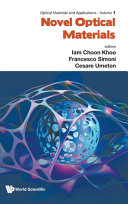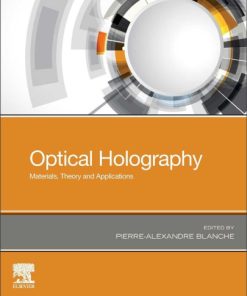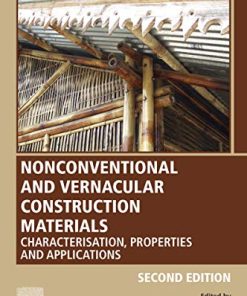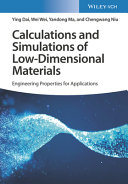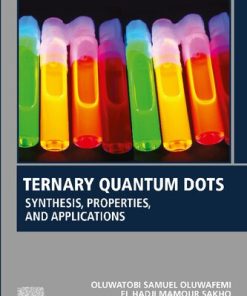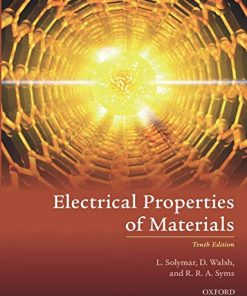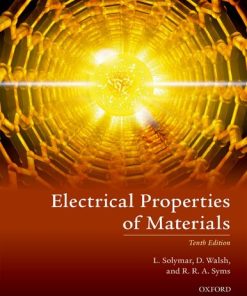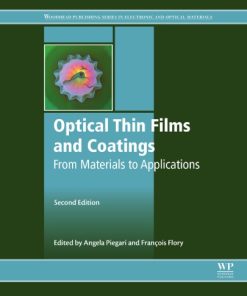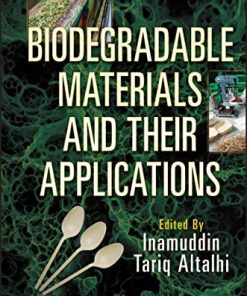Optical properties of materials and their applications 2nd Edition by Jai Singh 1119506050 9781119506058
$50.00 Original price was: $50.00.$25.00Current price is: $25.00.
Optical properties of materials and their applications 2nd Edition by Jai Singh – Ebook PDF Instant Download/DeliveryISBN: 1119506050, 9781119506058
Full download Optical properties of materials and their applications 2nd Edition after payment.
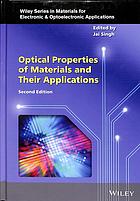
Product details:
ISBN-10 : 1119506050
ISBN-13 : 9781119506058
Author : Jai Singh
Provides a semi-quantitative approach to recent developments in the study of optical properties of condensed matter systems
Featuring contributions by noted experts in the field of electronic and optoelectronic materials and photonics, this book looks at the optical properties of materials as well as their physical processes and various classes. Taking a semi-quantitative approach to the subject, it presents a summary of the basic concepts, reviews recent developments in the study of optical properties of materials and offers many examples and applications.
Optical properties of materials and their applications 2nd Table of contents:
1 Fundamental Optical Properties of Materials I
1.1 Introduction
1.2 Optical Constants n and K
1.3 Refractive Index and Dispersion
1.4 The Swanepoel Technique: Measurement of n and α for Thin Films on Substrates
1.5 Transmittance and Reflectance of a Partially Transparent Plate
1.6 Optical Properties and Diffuse Reflection: Schuster–Kubelka–Munk Theory
1.7 Conclusions
Acknowledgments
References
2 Fundamental Optical Properties of Materials II
2.1 Introduction
2.2 Lattice or Reststrahlen Absorption and Infrared Reflection
2.3 Free Carrier Absorption (FCA)
2.4 Band‐to‐Band or Fundamental Absorption (Crystalline Solids)
2.5 Impurity Absorption and Rare‐Earth Ions
2.6 Effect of External Fields
2.7 Effective Medium Approximations
2.8 Conclusions
Acknowledgments
References
3 Optical Properties of Disordered Condensed Matter
3.1 Introduction
3.2 Fundamental Optical Absorption (Experimental)
3.3 Absorption Coefficient (Theory)
3.4 Compositional Variation of the Optical Bandgap
3.5 Conclusions
References
4 Optical Properties of Glasses
4.1 Introduction
4.2 The Refractive Index
4.3 Glass Interfaces
4.4 Dispersion
4.5 Sensitivity of the Refractive Index
4.6 Glass Color
4.7 Fluorescence in Rare‐Earth‐Doped Glass
4.8 Glasses for Fiber Optics
4.9 Refractive Index Engineering
4.10 Glass and Glass–Fiber Lasers and Amplifiers
4.11 Valence Change Glasses
4.12 Transparent Glass Ceramics
4.13 Conclusions
References
5 Concept of Excitons
5.1 Introduction
5.2 Excitons in Crystalline Solids
5.3 Excitons in Amorphous Semiconductors
5.4 Excitons in Organic Semiconductors
5.5 Conclusions
References
6 Photoluminescence
6.1 Introduction
6.2 Fundamental Aspects of Photoluminescence (PL) in Materials
6.3 Experimental Aspects
6.4 Photoluminescence Lifetime Spectroscopy of Amorphous Semiconductors by QFRS Technique
6.5 QFRS on Up‐Conversion Photoluminescence (UCPL) of RE‐Doped Materials
6.6 Conclusions
Acknowledgments
References
7 Photoluminescence, Photoinduced Changes, and Electroluminescence in Noncrystalline Semiconductors
7.1 Introduction
7.2 Photoluminescence
7.3 Photoinduced Changes in Amorphous Chalcogenides
7.4 Radiative Recombination of Excitons in Organic Semiconductors
7.5 Conclusions
Acknowledgments
References
8 Photoinduced Bond Breaking and Volume Change in Chalcogenide Glasses
8.1 Introduction
8.2 Atomic‐Scale Computer Simulations of Photoinduced Volume Changes
8.3 Effect of Illumination
8.4 Kinetics of Volume Change
8.5 Additional Remarks
8.6 Conclusions
References
9 Properties and Applications of Photonic Crystals
9.1 Introduction
9.2 PC Overview
9.3 Tunable PCs
9.4 Selected Applications of PC
9.5 Conclusions
Acknowledgments
References
10 Nonlinear Optical Properties of Photonic Glasses
10.1 Introduction
10.2 Photonic Glass
10.3 Nonlinear Absorption and Refractivity
10.4 Nonlinear Excitation‐Induced Structural Changes
10.5 Conclusions
Appendix Addendum: Perspectives on Optical Devices
References
11 Optical Properties of Organic Semiconductors
11.1 Introduction
11.2 Molecular Structure of π‐Conjugated Polymers
11.3 Theoretical Models
11.4 Absorption Spectrum
11.5 Photoluminescence
11.6 Non‐Emissive Excited States
11.7 Electron–Electron Interaction
11.8 Interchain Interaction
11.9 Conclusions
References
12 Organic Semiconductors and Applications
12.1 Introduction
12.2 Anode Modification for Enhanced OLED Performance
12.3 Flexible OLEDs
12.4 Solution‐Processable High‐Performing OLEDs
12.5 Conclusions
References
13 Transparent White OLEDs
13.1 Introduction—Progress in Transparent WOLEDs
13.2 Performance of WOLEDs
13.3 Emission Behavior of Transparent WOLEDs
13.4 Conclusions
References
14 Optical Properties of Thin Films
14.1 Introduction
14.2 Optics of Thin Films
14.3 Reflection‐Transmission Photoellipsometry for Determination of Optical Constants
14.4 Application of Thin Films to Energy Management and Renewable‐Energy Technologies
14.5 Application of Tunable Thin Films to Phase and Polarization Modulation
14.6 Conclusions
References
15 Optical Characterization of Materials by Spectroscopic Ellipsometry
15.1 Introduction
15.2 Notions of Light Polarization
15.3 Measureable Quantities
15.4 Instrumentation
15.5 Single Interface
15.6 Single Layer
15.7 Multilayer
15.8 Linear Grating
15.9 Conclusions
Acknowledgments
References
16 Excitonic Processes in Quantum Wells
16.1 Introduction
16.2 Exciton–Phonon Interaction
16.3 Exciton Formation in QWs Assisted by Phonons
16.4 Nonradiative Relaxation of Free Excitons
16.5 Quasi‐2D Free‐Exciton Linewidth
16.6 Localization of Free Excitons
16.7 Conclusions
References
17 Optoelectronic Properties and Applications of Quantum Dots
17.1 Introduction
17.2 Epitaxial Growth and Structure of Quantum Dots
17.3 Excitons in Quantum Dots
17.4 Optical Properties
17.5 Quantum Dot Applications
17.6 Conclusions
Acknowledgments
References
18 Perovskites – Revisiting the Venerable ABX3 Family with Organic Flexibility and New Applications
18.1 Introduction
18.2 Hybrid Perovskites in Photovoltaics
18.3 Light‐Emitting Diodes Using Solution‐Processed Lead Halide Perovskites
18.4 Ionizing Radiation Detectors Using Lead Halide Perovskite Materials: Basics, Progress, and Prospects
18.5 Conclusions
Acknowledgments
References
19 Optical Properties and Spin Dynamics of Diluted Magnetic Semiconductor Nanostructures
19.1 Introduction
19.2 Quantum Wells
19.3 Fabrication of Nanostructures by Electron‐Beam Lithography
19.4 Self‐Assembled Quantum Dots
19.5 Hybrid Nanostructures with Ferromagnetic Materials
19.6 Conclusions
Acknowledgments
References
20 Kinetics of the Persistent Photoconductivity in Crystalline III‐V Semiconductors
20.1 Introduction
20.2 A Review of PPC in III‐V Semiconductors
20.3 Key Physical Terms Related to PPC
20.4 Kinetics of PPC in III‐V Semiconductors
20.5 Conclusions
Acknowledgments
20.A On the Reaction Rate Under the Uniform Distribution
People also search for Optical properties of materials and their applications 2nd:
importance of optical properties of materials
explain optical properties of materials
colour and the optical properties of materials pdf
describe the optical properties of materials
applications of optical properties of materials
Tags: Optical properties, materials, their applications, Jai Singh
You may also like…
Engineering - Mechanical Engineering & Dynamics
Engineering
Physics - Solid State Physics




